- Home
- Crop Knowledge
- Vegetables
- Sweet Potato
Sweet Potato
- Nutrients
- Common Pests
- Crop Selection
- Documents
| Crop Stage Images |  |
 |
|
|---|---|---|---|
| Period of Doses | Pre-sowing Doses | After 30 Days | |
|
Nutrients (Kg/ha) |
N | 45 | 45 |
| P | 60 | – | |
| K | 90 | – | |
Deficiency of Nutrients:
| Nutrients | Nitrogen (N) | Phosphorus (P) | Potassium (K) | Calcium (Ca) |
|---|---|---|---|---|
| Nutrients Deficiency |  |
 |
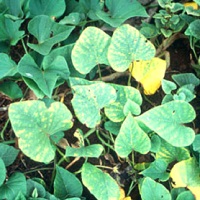 |
 |
| Deficiency Symptoms | 1. Deficiency of N causes dramatic reductions in the growth of sweet potato plants and yet it is not easily recognised in the field.
2. General symptoms are a uniform light green chlorosis of the leaves, and slow growth resulting in a delayed or sparse ground cover. 3. These symptoms may be obvious in comparison with healthy plants, but less apparent in a uniform crop. |
1. The first sign of P deficiency is usually the premature senescence of older leaves.
2. Yellowing may spread from discrete interveinal patches, 3. In this case, the chlorotic areas may appear orange or red due to the overlying anthocyanin pigments. |
1. K deficiency can cause substantial growth reduction before specific symptoms develop.
2. In the field, symptoms often develop after two to three months, when the expanding storage roots begin to place increased demand on K supplies. 3. Brown necrotic lesions develop within the chlorotic zones and eventually spread to cover the entire leaf blade. |
1. The primary symptom of Ca deficiency is the development of necrotic tissue on young leaves.
2. The necrosis usually begins along the lateral margins and extends inward mainly in interveinal tissue 3. Necrosis is not usually preceded by localised chlorosis, although the leaves may be uniformly paler than normal. |
| Nutrients | Sulphur (S) | Magnesium (Mg) | Iron (Fe) | Boron (B) |
|---|---|---|---|---|
| Nutrients Deficiency | 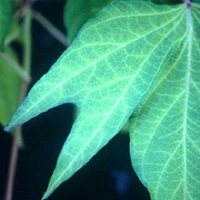 |
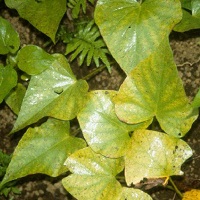 |
 |
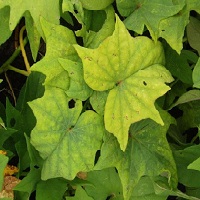 |
| Deficiency Symptoms | 1. Sulfur deficiency results in a uniform pale green chlorosis throughout the plant.
2. Veins do not retain a green colour, and in many cases, they may be more chlorotic than the interveinal tissue. 3. In which young leaves are normally green (ie. lacking red pigmentation), the youngest leaves may appear chlorotic earlier or more severely than mature leaves. 4. This is not obvious in cultivars with red or purple tips. |
1. An Mg-deficient crop will tend to have a pale overall colour.
2. The earliest specific symptom of Mg deficiency is interveinal chlorosis of older leaves. 3. Typically, the main veins retain a relatively broad margin of dark green tissue, but the minor veins are less well defined, resulting in radial bands of pale tissue between the main veins. |
1. The distinctive symptom of Fe deficiency is chlorosis of the youngest leaves.
2. Yellow interveinal chlorosis develops, which is characterised by a sharply contrasting green network of veins. 3. However, as the condition becomes more severe, the chlorosis becomes white and the veins may lose their green colour. 4. If young leaves are normally purple, they become pink as a result of Fe deficiency. |
1. Boron deficiency affects actively growing tissue, both of the shoots and roots.
2. The first sign is usually a thickening of young leaves. 3. The leaves and stem near the shoot tip are brittle and break easily when bent. 4. Young leaves are usually paler than the older leaves but the extent and pattern of chlorosis are variable. |
| Images Of Pest Life cycle: | 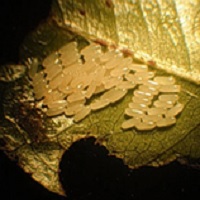 |
 |
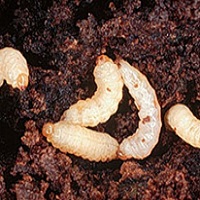 |
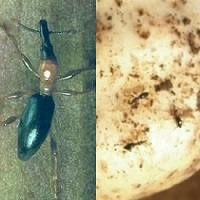 |
|---|---|---|---|---|
| Stages: | Egg | Larvae | Pupae | Adult |
| Mark Of Identification: | 100-200, on the tubers & stems of vines by making small cavities. |
Small, legless & pale yellow in colour with a brown head. | Pupation in the Larva larval burrows in vines. |
Small, ant-like, 6-8 mm long. Head is bluish brown, thorax & legs brownish red and antenna bright red in colour. |
| Life Cycle: | 5-7 Days. | 8 Days. | 15 Days. | 10 Days. |
Management (Pest Control):
| Chemical: | Spray with 0.1 % carbaryl. Apply phorate 10 G in the soil at planting @ 10 kg/ha. |
|---|---|
| Organic: | Spray G Agro Beau 5gm/lit 2 to 3 spray at 21 days interval. |
| Images Of Pest Life cycle: |  |
 |
 |
 |
|---|---|---|---|---|
| Stages: | Egg | Larvae | Pupae | Adult |
| Mark Of Identification: | Eggs are sub-spherical in shape. | Green to dark brown in colour with reddish patches on sides and a curved horn-like process at the anal end. | Pupae are reddish-brown in colour and pupation takes place in the soil. | Moths are stout, pale grey in colour having a pale grey wing. |
| Life Cycle: | 5-10 Days. | 14-21 Days. | 7-11 Days. | 15-20 Days. |
Management (Pest Control):
| Chemical: | Dusting the crop with 10% carbaryl dust @ 20 kg/ha. |
|---|---|
| Organic: | Spray G Agro Beau 5gm/lit + G Agro Meta 5ml/lit 2 to 3 spray at 21 days interval. |
| Seed Variety | Characteristics | Crop Duration (Days) |
Crop Yield (qtl/acre) |
|---|---|---|---|
| Punjab Sweet Potato-21 | 1. The vines of this variety are medium long in length. 2. It contains deep red colour tubers having white flesh which is 20cm long and 4cm wide. |
145 | 75 |
| Varsha | 1. It is recommended to grown in Maharashtra. 2. It is suitable to grow in the rainy season. |
130 | 62.5 |
| Konkan Ashwini | 1. It is a short duration crop and gives a high yield. 2. This variety is developed to be cultivated in Maharashtra. |
140 | 75 |
| Sree Arun | It is an early maturing variety having pink colour skin and cream colour flesh. | 100-120 | 83-116 |
| Sree Kanaka | It has cream colour skin tuber which has dark orange colour inner flesh. | 110 | 41-62.5 |
| Sree Varun | It contains cream colour skin of the tuber. | 90-100 | 80-110 |

